The national pastime truly gained that distinction in the early 20th century, as the game attracted throngs of devoted fans to each major league contest. The earliest ballparks, built of wood in the late 1800s, were quickly worn down by growing daily attendance and weather conditions, or lost entirely to fire or other natural disasters. The first ballparks built primarily with reinforced concrete and steel, known as jewel box parks, were meant to stand as permanent homes to the clubs of the National and American Leagues, and accommodate a legion of American fans crazed by baseball.
As with everything man-made, obsolescence is inevitable. Steel rusts. Concrete cracks. Wood rots. As the jewel boxes reached their fourth and fifth decades of service, teams and municipalities were looking for more from their home facilities. The New York Giants, Brooklyn Dodgers, Boston Braves and Philadelphia Athletics all left their storied homes to relocate to points west in the 1950s.1 Cincinnati, New York, Philadelphia, Pittsburgh and St. Louis all built cookie-cutter multipurpose stadiums to house their baseball clubs in the ‘60s and ‘70s, sharing the facilities with football teams and often hosting concerts and special events. Jewel boxes in downtown Detroit, The Bronx and the southside of Chicago would survive until the 1990s and early 2000s before being replaced with modern ballparks.
Only two of the classic jewel box ballparks remain: Boston’s Fenway Park, opened in 1912, and Wrigley Field, home of the Chicago Cubs since 1914. Both parks hold National Historic Landmark status, meaning that any renovations must be made in a manner that respects the historic character of the ballpark. By heavily leaning into their storied pasts and amplifying the timeless experience of attending a ballgame, Wrigley and Fenway are the closest thing we have to time machines that can transport us back to the days when baseball was a dominant force in American culture.
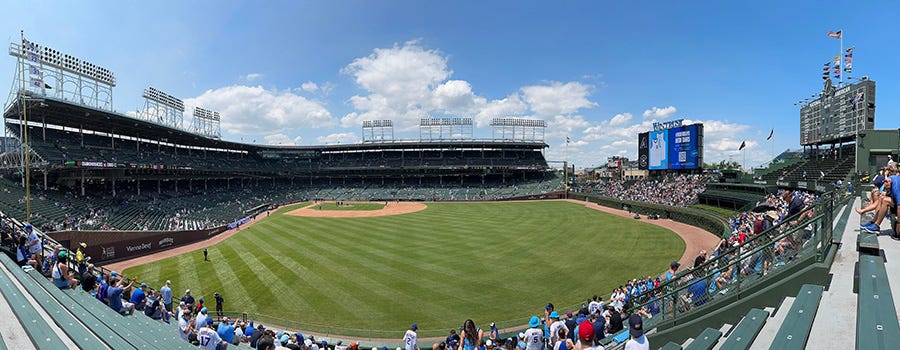
Having spent most of the All-Star break vacationing in Door County, Wisconsin, I drove south to Chicago, eschewing a typical lunch stop in Milwaukee to avoid getting caught up in the happenings surrounding the Republican National Convention.2 My first stop was at the Chicago White Sox team store at Guaranteed Rate Field, where I bought a souvenir pin that I was unsuccessful in obtaining the previous week. I trekked my way back to the north side, opting for Lake Shore Drive through downtown as opposed to the Dan Ryan expressway, which was — per usual — hopelessly congested. I set up camp at Russ and Jeff’s place in Buena Park, about a mile north of Wrigley Field, and devoted the remainder of the evening to takeout hot dogs, NBA highlight videos on YouTube and uproarious laughter.3
Chicago is a place that’s far from foreign to me: I’ve visited the city dozens of times over the past 25 or so years and even entertained the possibility of moving there before ultimately settling on Columbus. In many ways, it’s the same city I’ve known and loved all my life. In other ways, it has fundamentally changed from how I remember it. It’s also dense and diverse and sprawling and evolving, making each visit ripe for new discovery.
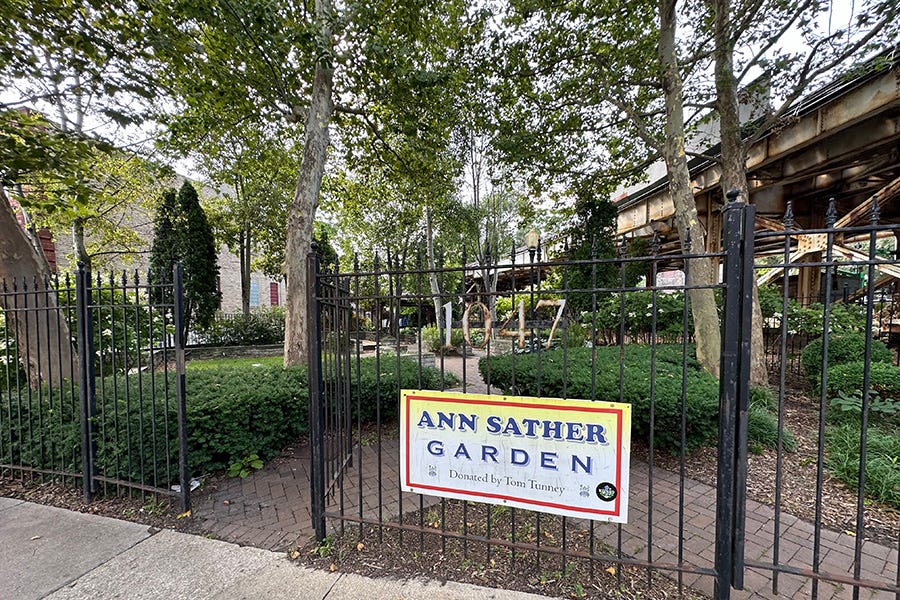
The morning of the game, I headed down to the ballpark early, walking south along the streets and park paths that run parallel to the CTA Red Line train. For most Cubs games, I would ride the train to the Addison station, but Russ and Jeff’s place is less than a mile from Wrigley Field — two stops on the train — and it was an absolutely gorgeous morning for a stroll with a cold brew coffee from Drink Happy Thoughts in hand.
I got to Waveland Avenue just before 10:30 a.m. with plans to meet my friends Mike and Dave at the Gman Tavern for a pregame drink. I bought bleacher tickets for the game the moment they went on pre-sale, knowing that this was pretty much the only date I was going to be able to make work for Wrigley Field in my trip routing. Plus, Cubs tickets are hot items, even for Friday afternoon games and especially for the general admission bleachers where the best seats are first-come, first-served on the day of the game. As of 10:30 a.m., there were only a handful of people in line for entry an hour before gates opened. Breathing a sigh of relief after previous ballpark experiences on days with a giveaway — more on that later — I did a lap around Sheffield Avenue, Addison Street and Clark Street, aka Wrigleyville.

While the ballpark still evokes a stately grace worthy of its 110-year history, the surrounding neighborhood is electrified with revelers in their finest Cubbie blue each gameday, throwing caution to the wind, sloshing from bar to bar, splurging on merchandise — some licensed by the team and some not — and sharing an experience that millions of baseball fans have delighted in for the past 110 years. The neighborhood and the businesses that benefit from proximity to Cubs baseball have evolved over time, even as the ballpark serves as a sort of time capsule.
The state of Illinois legalized sports betting in 2019, and just two seasons later, a DraftKings sportsbook was added to the exterior of Wrigley Field, near the corner of Addison and Sheffield. It’s highly ironic to me that the same city — though not the same MLB franchise — responsible for the most egregious game fixing event in baseball history would allow gambling practically inside the ballpark. This is the same league that banned all-time hit king Pete Rose from the game for life and continues to deny him enshrinement in the Hall of Fame. This is the same league that had to investigate and entertain the possibility of banishing the best player in the game today, pitcher/designated hitter Shohei Ohtani, when evidence surfaced that his interpreter had racked up millions in gambling debts. Give me a little consistency here, Major League Baseball.
Gman Tavern wasn’t quite open yet when I tugged on the door at 10:55, so I popped over to the Billy Goat Tavern a few doors down for a pre-pre-game Old Style. When I texted Mike and Dave to meet me there first, I caught Mike by surprise as the bar in which I was sitting was previously known as the Full Shilling Public House, having only been transformed into a Billy Goat location a few months prior.
With a first round successfully downed, we hopped back over to Gman for a second. I had a modified “Chicago Handshake,” traditionally a shot of Malort and an Old Style chaser, substituting a helles lager from Dovetail Brewery for the Windy City staple Old Style lager. I absolutely love the Gman Tavern, a little neighborhood hangout with a great tap list and live music most nights of the week. I’ve played a ton of shows in Chicago, where the “bar in the front, music in the back” layout of a rock club is pretty standard, versus the “one big, loud room” that rules in our hometown scene. While it can be demoralizing playing to a mostly empty room while the bulk of the crowd is socializing around the bar, as a patron I secretly appreciate the ability to temporarily escape a band that’s not clicking with me.
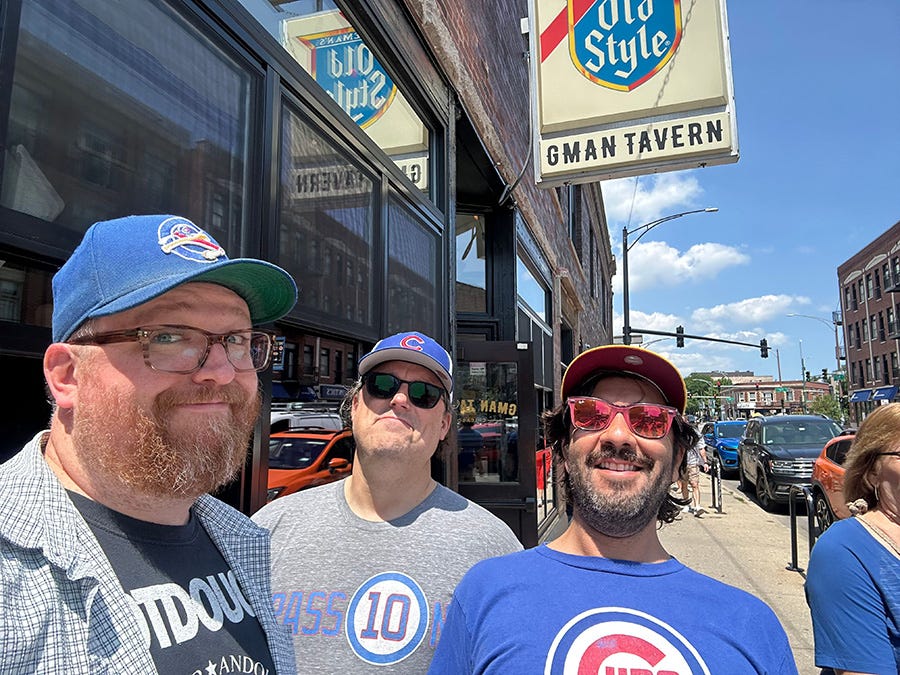
Our pre-game festivities had dragged on close to noon, so we made our way over to the ballpark to collect our swag and claim our seats. The Cubs have been giving away mesh tank tops at selected Friday afternoon games this season, each drawing inspiration from a different era of team uniforms. The first 5,500 fans with bleacher tickets got a baby blue tank with white pinstripes, paying homage to the 1978 Cubs road uniforms.4 We made it in plenty of time to collect the promo giveaway and we swiftly shed our more modest shirts in favor of the new, farmer tans be damned.
Even though we had made it through the gates in plenty of time to plant our flag on some decent seats close to the wall, we opted to hang back toward the top of the right field bleachers. The wind was lazily blowing out to left field, so most fans had flocked in that direction in hopes of catching a home run ball. Spoiler alert: none of them did.
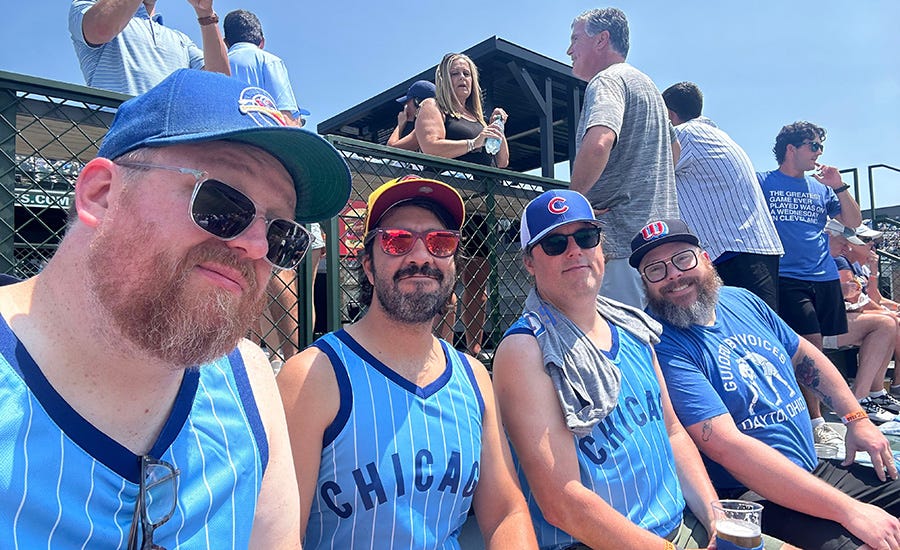
If you don’t have a bleacher ticket, Wrigley Field does not allow you to enter the bleachers section. There’s not much out there that you can’t get in other parts of the park, with the notable exception of Hot Doug’s sausages. Chef Doug Sohn opened Hot Doug’s in 2001, a sausage emporium offering standards like the Chicago dog, bratwurst and Polish sausage, alongside gourmet specials like a sauternes duck sausage topped with foie gras, truffle pork sausage, escargot and guanciale sausage, as well as a variety of game meats ranging from elk to rattlesnake. The delectable and affordable offerings attracted tons of diners, often leading to wait times reaching three to four hours as the line stretched down the street from the restaurant.
Sadly, Hot Doug’s closed in 2016. I had visited probably a dozen times: it was a non-negotiable for any trip to Chicago. I’d get in line about 45 minutes to an hour before doors opened on a Friday or Saturday, wait close to two hours, get inside and chat with Doug as I placed your order, then find a place to sit and wait for the highest expression of encased meats on the planet to be delivered to my table. I generally abhor waiting more than 30 minutes for food from a restaurant, but I gleefully broke that rule for Hot Doug’s. Calling it my favorite restaurant of all time is not an exaggeration and I miss it so very much.
Shortly after closing the storefront, Sohn announced that he would have a Hot Doug’s stand inside Wrigley Field, serving a very limited menu of rotating special sausages named for former Cubs players, as he often did with his “Celebrity Sausages” at the restaurant. However, being located in the bleachers, it is only accessible to fans with bleacher tickets, a fact I learned on a 2022 visit to Wrigley when my hopes of tasting Hot Doug’s again were dashed because our seats were in the field boxes down the first base line.
Before the start of the game, I treated Mike, Dave and Russ, who joined us late, to a round of Hot Doug’s. Dave and Russ chose the Les Lancaster, a beef and pork Thuringer sausage topped with beer mustard, caramelized onions and cheddar cheese. Mike and I opted for the Heathcliff Slocumb, a curry pork sausage garnished with curry dijonnaise and Swiss cheese. I’ll be honest, this version of the Hot Doug’s experience lacks both in the charm and whimsy of the original restaurant, as well as in the quality of the food. That said, our group can report that both sausages were very good, and I’d estimate they were maybe 70-75% as good as what used to be served at the brick-and-mortar hot dog joint. I’ll give credit where credit is due: even though this stand is staffed and run by Wrigley Field’s concessionaire and not by Doug himself, they do an admirable job and a Hot Doug’s sausage is still better than a lot of the supposedly high-concept food options I’ve tried at other ballparks.
The game itself started at 1:20 p.m., as all Wrigley Field Friday games do, a throwback to the day games played regularly before lights were installed there in 1988.5 This was the first game to be played after the All-Star break, with the visiting Arizona Diamondbacks sending pitcher Ryne Nelson to the mound to face off against Cubs starter Justin Steele. The D-backs small balled their way to a 3-0 lead in the top of the third inning on RBI singles by catcher Gabriel Moreno and first baseman Christian Walker. Two more runs in the top of the fifth would knock Steele out of the game, while Nelson put up one of his best outings of the season, giving up just one run on three hits and striking out nine Cubs batters over five and two-thirds innings. Chicago would eke out one more run in the bottom of the eighth inning, but not enough to overcome the talented Arizona bullpen, falling 5-2. The “W” flag, hoisted after each Cubs home win, would stay safely folded at the base of the mast.6
The Cubs weren’t the only losers on this day. Bleacher bums regularly contribute their empty beers to form a cup snake, with the goal of reaching from the outfield wall to the back of the section before another section’s snake is able to do so. Left field, packed with early arrivers, raced to an early advantage. By the time our right field cohort got the idea to combine our two smaller snakes into one, Wrigley Field staff arrived to break up the party and dispose of our thousands of beer cups.
I also suffered a personal loss, as I had the dumb idea to try to even out my farmer tan by only applying sunblock from the elbow down. Predictably, my upper arms took on the shade of a mostly cooked lobster by the end of the game, and as of this writing nearly three days later, they are a tender, chafed reminder of what a stupid decision I made.
Wrigley is the kind of place where, no matter the quality of the product on the field, you can get an experience unrivaled in the more modern parks that dominate the game today. I’ve personally been to Wrigley Field a half dozen times, and the charm of the place never wears off. This is a shrine to baseball as it was when it became a national obsession, transporting today’s fans back in time for a pleasant and memorable day in the sun.
NEXT GAMES:
Milwaukee Brewers at Minnesota Twins, Saturday, July 20, 6:10 p.m., Target Field
Arizona Diamondbacks at Kansas City Royals, Monday, July 22, 7:10 p.m., Kaufmann Stadium
Chicago White Sox at Texas Rangers, Thursday, July 25, 1:35 p.m., Globe Life Field
Los Angeles Dodgers at Houston Astros, Friday, July 26, 7:10 p.m., Minute Maid Park
The St. Louis Browns also moved in the ‘50s, but to the east, becoming the Baltimore Orioles.
Police officers on loan from my home of Columbus, Ohio shot and killed an unhoused man in a physical confrontation with another man about a mile from the convention’s security perimeter. I want to say something snarky and derisive about my city’s “shoot first” police force, but I’m just ashamed that first option deadly force is such a commonplace and normalized law enforcement tactic.
I had entertained the notion of going to the first night of the PRF BBQ, the annual music festival organized by contributors and participants of the Electrical Audio message board. I used to post there occasionally back in the late 2000s/early 2010s, and I even played the PRF BBQ once with my short-lived Silkworm cover band in 2015, but ultimately I wanted to spend that time with my friends. We can FOMO our way into all manner of experiences, but there’s only so much time we have on this planet to spend with the people that we care about.
The innovative jersey was one of the only things interesting about the Cubs that year, as they finished with a disappointing 79-83 record.
Wrigley was the last ballpark in the majors to add lights, and only under threat from MLB that they would not be permitted to host any postseason games. The Cubs, being ever hopeful despite a championship drought that dated back to 1908 and not even reaching a World Series since 1945, capitulated.



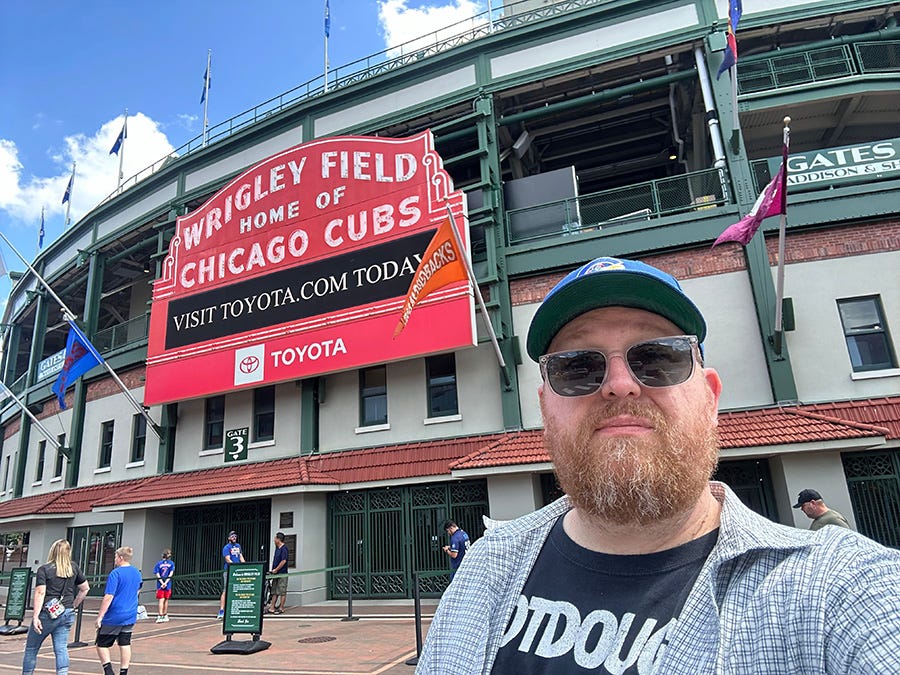
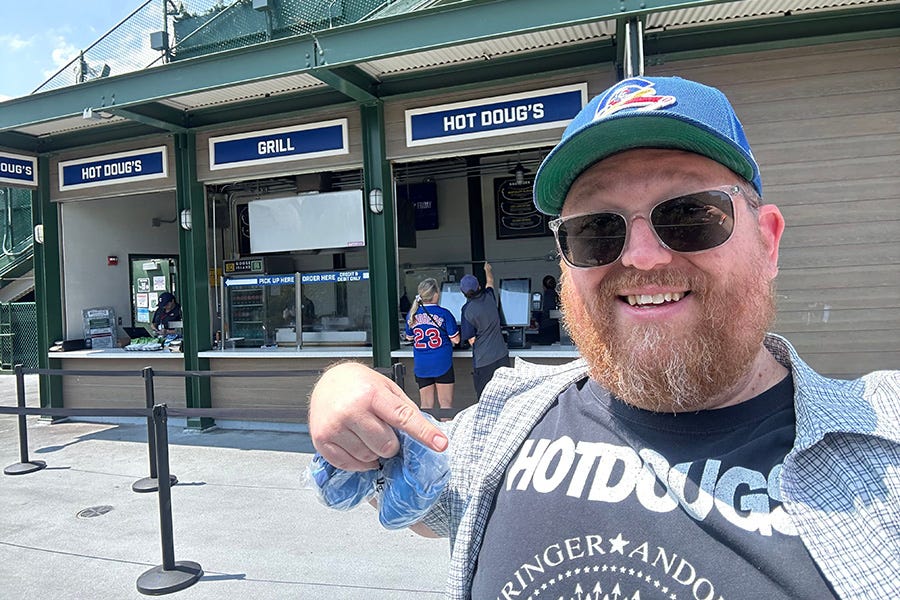
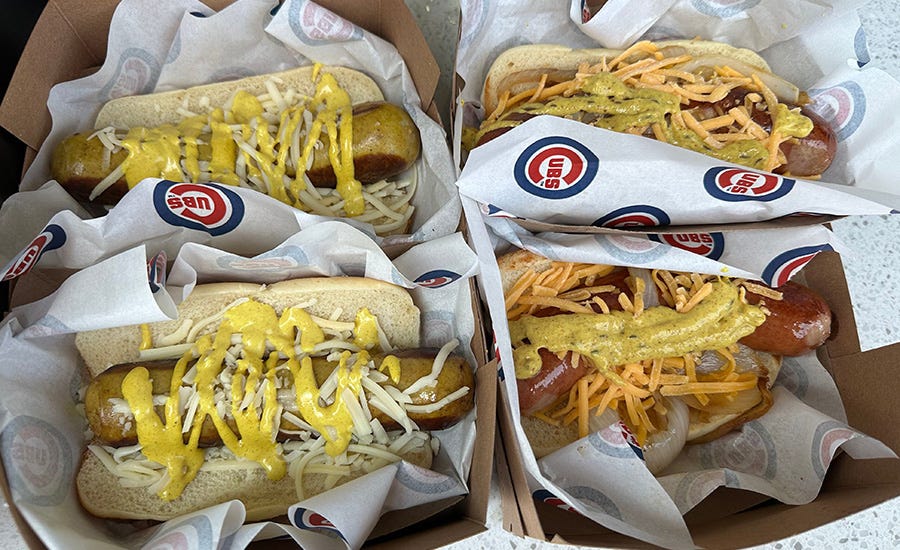
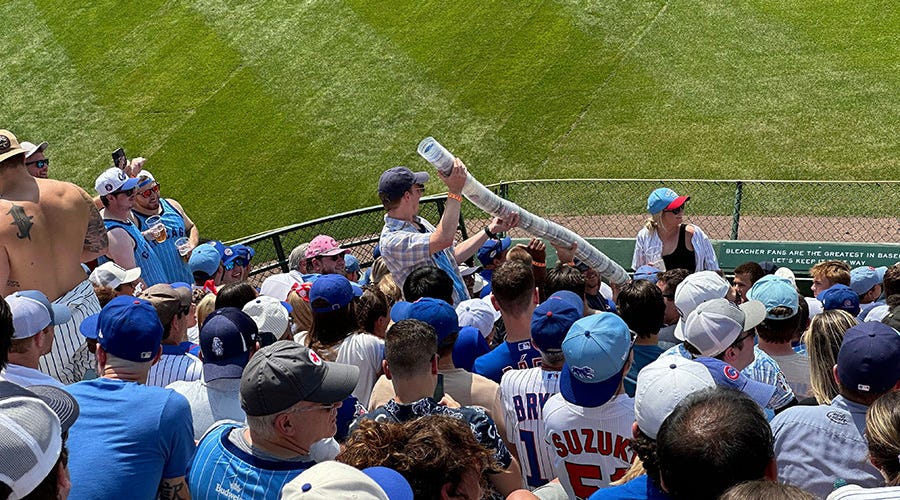
I should've read to the end prior to posting comments. Excellent Stadium chow review, I'm craving a Hot Dougs and lunch is still about 3 hours away. Might treat myself to Criff Dogs in the East Village today.
The Cup snake got escorted out by security? Was it caught on camera making disparaging comments about the Ricketts? (Go to hell Joe!)
Your poor dermis! That tank top rules but I thought we established the importance of thorough sunscreen coverage. Pale Force forevah MFer!
That "The greatest game that was ever played was on a Wednesday in Cleveland" t-shirt is pretty awesome.